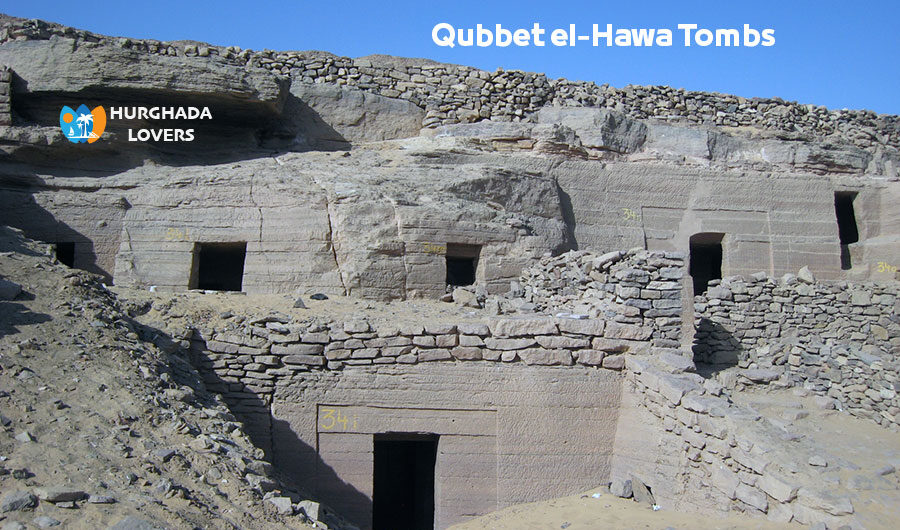Qubbet el-Hawa Tombs – Tombs of The Nomarchs (Governors) in Elephantine “Dome of the Wind” Aswan, Egypt | Egyptian Tombs
Facts and History of the Pharaonic Civilization “Ancient Egypt History” to Build the Most Important Egyptian Tombs for Nobles and Rulers in Ancient Egyptian Civilization, How Much is the Entry Ticket, Working Hours, and More about Egypt Archaeological Sites.
The Dome of Air is a mountainous area that is considered one of the most prominent landmarks and archaeological sites in Egypt in Aswan, and it is one of the places that has a history with the various pharaohs “Female Pharaohs” and queens of Ancient Egypt who ruled in ancient Egypt “Egyptian Pharaohs kings“.
This area is considered a large cemetery for a number of nobles, priests and religious men from the Pharaonic era until the Islamic Egypt History.
in addition to being one of the most important places for the manufacture of bronze, the most famous Ancient Egyptian Metallurgy in which the ancient Egyptians excelled to know more about Ancient Egyptian Government.
Many bronze making tools and molds made from it were found in this area to discover the period of development of the Industry in ancient Egypt.
Qubbet el-Hawa Tombs Facts
Where is the air dome located? And when was it discovered?
Mount Qubbet el-Hawa is located in Aswan, on the west bank of the Nile River.
The Qubbet el-Hawa tombs were discovered in 1946, and excavation and digging continued until 1959. Its discovery was a joint collaboration between Egyptian Egyptology and archaeologists: Labib Habashi and Mohieddin, in addition to a mission from the University of Bonn in Germany..
Why is the air dome called by this name?
The Qubbet El-Hawa tombs are called so because they are a rocky mountain that reaches a height of 130 meters. As for El-Hawa, it is the title of one of the righteous saints (Sidi Ali bin El-Hawa) who lived in this area and was buried there. H
is grave was turned into a shrine. This shrine is located on the southern summit of the mountain, indicating the development of Architecture in ancient Egypt and the art of Sculpture in Ancient Egypt.
Description of the air dome
The air dome is a number of chambers that were dug inside the mountain in different sizes. The walls of the chambers were decorated from the inside with pictures of the daily life of the ancient Egyptians and learning about the Social Structure in Ancient Egypt.
Such as: fishing and birds, visiting friends and acquaintances, slaughtering cows, training in carrying arrows in the Military of ancient Egypt, and playing Music in Ancient Egypt.
The Qubbet el-Hawa tombs consist of 85 tombs, in addition to 10 newly discovered tombs. Most of them date back to the reign of the kings of the Sixth Dynasty of Egypt, starting with the reign of king Teti in the Old Kingdom of Egypt period, to the Twelfth Dynasty of Egypt in the Middle Kingdom of Egypt period, beginning with the reign of King Amenemhat I.
These tombs were carved on three levels and at a high altitude on the mountain. The Qubbet el-Hawa tombs can be reached via two stone paths that slope towards the eastern side of the Nile, and have now been prepared to facilitate the ascent and descent of visitors..
What are the most important tombs discovered in the Jebel al-Hawa area?
Tomb of Herkhuf – Qh34n
Tomb of Khui – Qh34e
Tomb of Mekhu – Qh25
Tomb of Sabni I – Qh26
Tomb of Sarenput I – Qh36
Tomb of Sarenput II – Qh31
Tomb of Amenhotep: It is the largest tomb in these Qubbet el-Hawa tombs, as the facade of the tomb occupies about 12 meters, and contains distinctive inscriptions..
Khons Tomb: This tomb dates back to the Old Kingdom, and is located east of the tombs dating back to the New Kingdom..
Tomb of (Wusrat Satit): It is one of the tombs of the modern state..
Tomb of Mahu: He is one of the wealthy people who lived during the era of the Sixth Dynasty. The width of this tomb reaches 150 square meters, and consists of a hall and a large room with a ceiling raised by about 6 columns, in addition to a room for worship. There is a passage in this tomb that ends in another tomb called the Tomb of Sabni.
Tomb of Sabni: Sabni is the son of Mahu, and this tomb is large, reaching 120 square meters, and the tomb hall rises with about 14 columns. Sabni was the governor of the southern lands, as in the Geography of ancient Egypt, and the seal bearer of King Pepi II and a priest of ceremonies. Both the tomb of Sabni and Mahu end with two stairs that end on the banks of the Nile..
Sobekhotep’s tomb: It covers an area of about 15 square meters. In this tomb, 55 bottles containing important manuscripts were found indicating the owner of the tomb..
Tomb of Sanburt I: It is one of the tombs of the Middle Kingdom. Sanburt I was the governor of Nubia during the reign of King Senusret I. It is one of the large tombs in Qubbet el-Hawa..
In the Coptic period: At the bottom of this mountain was the monastery of Anba Saint George, in which he lived and was buried..
From the Islamic era: There is the shrine of Sidi Ali bin al-Hawa, as we mentioned previously..
Visit ticket price
Note: Facts and secrets of the history will be added soon…
Hurghada Excursions Lovers, Best Travel Agency in Hurghada to provide daily tours to visit the Tourist attractions of Luxor by Hurghada to Luxor Tours and Hurghada to Pyramids Trips. Book online when you come to Hurghada, El Gouna, Sahl Hashish, Makadi Bay, Soma Bay, Egypt Tours Packages.

